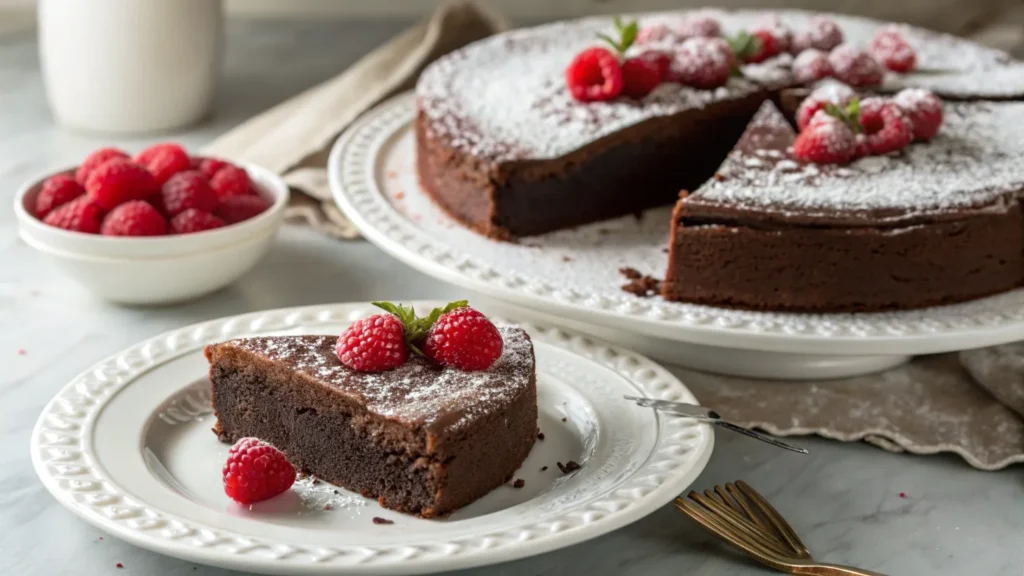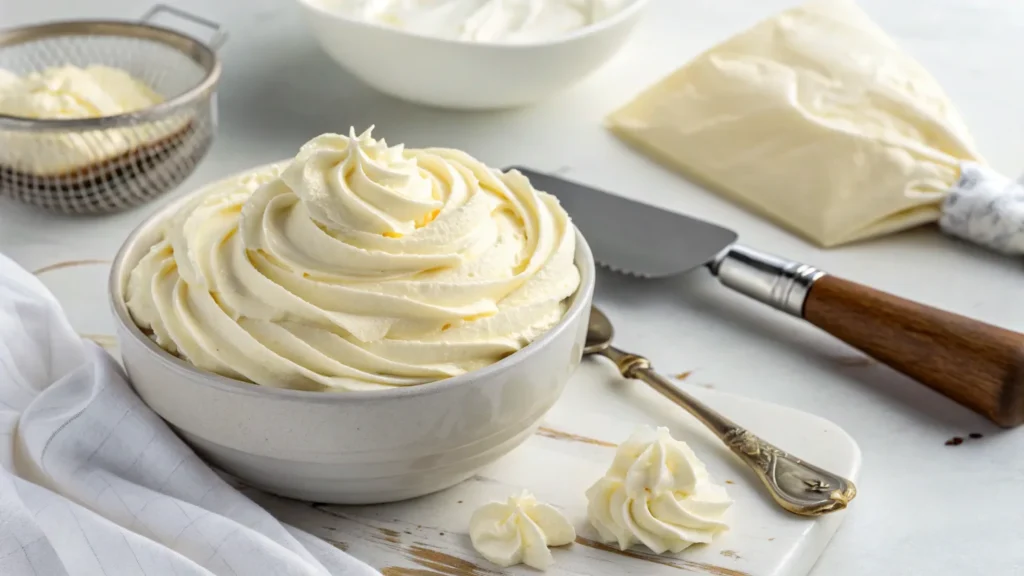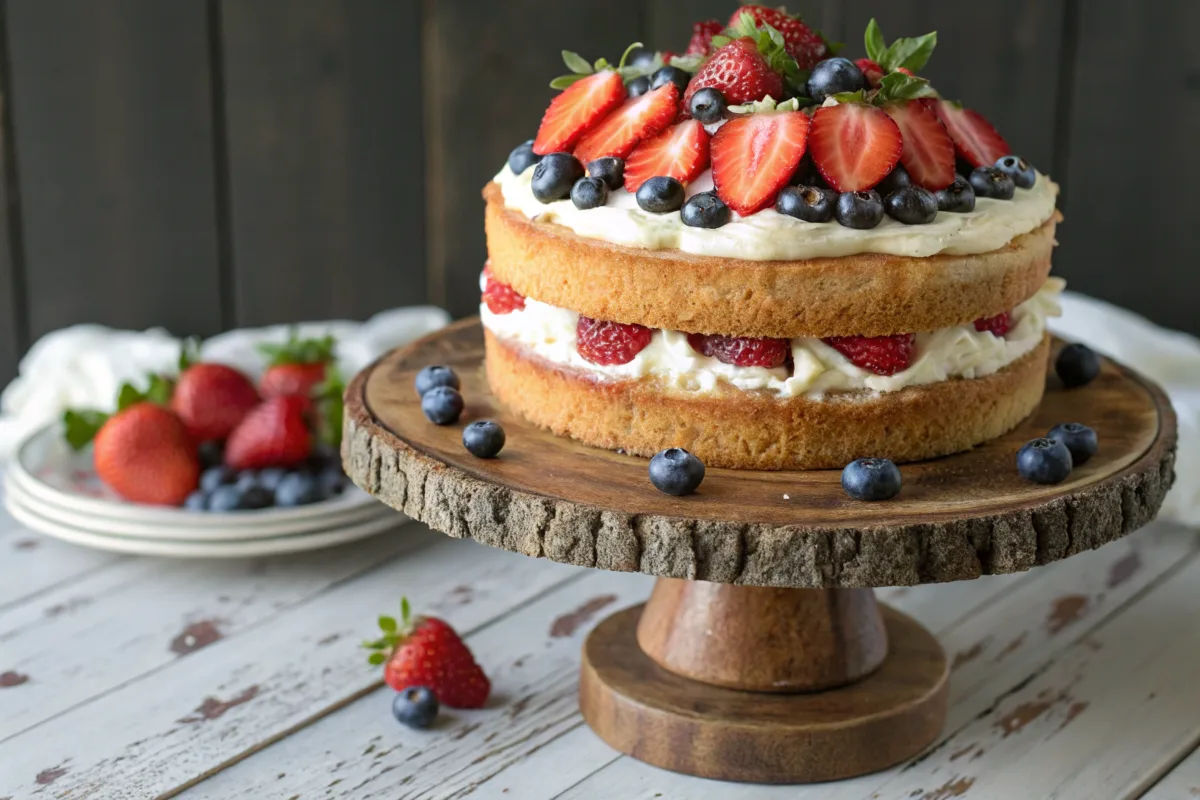Introduction to Gluten-Free Cakes
Gone are the days when gluten-free baking meant dry, crumbly desserts. With the right ingredients and techniques, you can make gluten-free cakes that are just as moist, flavorful, and satisfying as traditional ones. Whether you’re baking for someone with celiac disease, gluten intolerance, or simply looking to try something new, gluten-free cakes are a fantastic way to enjoy inclusive and health-conscious desserts.
Looking for more ways to stay healthy? Check out our guide to High Protein Breakfast Ideas for delicious, energy-packed mornings.
Table of Contents
Why Choose Gluten-Free Cakes?
There are several reasons why gluten-free cakes are gaining popularity, from health concerns to evolving baking trends:
- For Health and Allergies:
- Many people need to avoid gluten due to conditions like celiac disease or non-celiac gluten sensitivity. Gluten-free cakes allow them to enjoy baked goods without discomfort.
- Inclusive Baking:
- Gluten-free desserts ensure that guests with dietary restrictions don’t feel left out during celebrations.
- A Cleaner Approach to Baking:
- Many gluten-free recipes incorporate whole, minimally processed ingredients like almond flour and coconut flour, which are naturally nutrient-dense.
Overview of Gluten-Free Baking
Baking without gluten comes with unique challenges, but it’s also an exciting opportunity to experiment with new ingredients. Gluten-free cakes often require:
- Alternative Flours:
- Gluten-free flours like almond, coconut, and rice flour lack the elasticity of traditional wheat flour. Binders like xanthan gum or psyllium husk are often added to mimic gluten’s structural role.
- Moisture Retention:
- Gluten-free cakes can dry out quickly, so recipes often include ingredients like yogurt, applesauce, or buttermilk to keep them moist.
- Trial and Error:
- Baking times and temperatures may need to be adjusted to achieve the desired texture and consistency.
Ingredients for Gluten-Free Cakes
The secret to a perfect gluten-free cake lies in the choice and combination of ingredients. From alternative flours to natural sweeteners, these ingredients not only make the cake safe for those with gluten sensitivities but also elevate its flavor and texture. Let’s take a closer look at the essentials.
What is Gluten-Free Cake Made Of?
Gluten-free cakes rely on alternative flours and binders to replace the structure that gluten provides in traditional baking.
- Gluten-Free Flours:
- Almond Flour: Adds moisture and a nutty flavor. Best for dense, moist cakes.
- Coconut Flour: Absorbs liquid well, making it perfect for soft, fluffy cakes.
- Rice Flour: A neutral-tasting flour that’s great for light, airy cakes.
- Oat Flour: Provides a hearty texture and mild sweetness.
- Sorghum Flour: Often used in blends for its wheat-like texture.
- Binders:
- Since gluten-free flours lack elasticity, binders like xanthan gum or psyllium husk are added to hold the cake together.
- Eggs are also commonly used to provide structure and stability.
- Moisture-Retaining Ingredients:
- Gluten-free cakes can dry out easily, so ingredients like applesauce, yogurt, or buttermilk are often included to keep them soft and moist.
Natural Sweeteners and Additives
- Sweeteners:
- Maple Syrup and Honey: Add natural sweetness and enhance the flavor.
- Coconut Sugar: A low-glycemic alternative to refined sugar with a caramel-like flavor.
- Flavor Enhancers:
- Vanilla Extract: Adds warmth and depth to the cake.
- Citrus Zest: Brightens the flavor of the cake and pairs beautifully with almond or coconut flour.
Avoiding Cross-Contamination
When baking gluten-free, avoiding cross-contamination is crucial:
- Certified Gluten-Free Ingredients: Ensure that your flours, sweeteners, and other ingredients are labeled gluten-free.
- Dedicated Tools: Use separate mixing bowls, baking pans, and utensils to avoid traces of gluten from previous recipes.
- Clean Workspaces: Thoroughly clean countertops and any appliances that may have come into contact with gluten.
Pro Tip:
If you’re experimenting with new flours, start with a trusted gluten-free flour blend. Many brands are pre-mixed to ensure the perfect balance of texture and flavor.
Best Gluten-Free Flours for Cakes
Choosing the right flour is the foundation of a great gluten-free cake. With so many options available, it’s essential to understand the characteristics of each type of flour and how they work in baking. Whether you prefer single-origin flours or blends, this guide will help you select the best flour for your next gluten-free creation.

Single-Origin Flours
- Almond Flour
- Texture and Flavor: Adds a rich, nutty flavor and a moist texture, making it ideal for dense cakes like pound or carrot cake.
- Best Used For: Cheesecakes, brownies, or as part of a flour blend.
- Pro Tip: Almond flour is not the same as almond meal. Always use finely ground almond flour for smoother results.
- Coconut Flour
- Texture and Flavor: Absorbs a lot of liquid, resulting in a soft, fluffy texture with a hint of sweetness.
- Best Used For: Light cakes like sponge or vanilla cakes.
- Pro Tip: Use coconut flour sparingly, as a little goes a long way. Generally, 1/4 cup of coconut flour replaces 1 cup of regular flour.
- Rice Flour
- Texture and Flavor: Mild, neutral taste with a slightly gritty texture if used alone. Works best when blended with other flours.
- Best Used For: Cakes that need to be light and airy, like chiffon cakes.
- Oat Flour
- Texture and Flavor: Adds a hearty, chewy texture and a subtle sweetness.
- Best Used For: Cakes with fruit, like apple or banana cake.
- Pro Tip: Ensure your oats are certified gluten-free to avoid cross-contamination.
- Sorghum Flour
- Texture and Flavor: Closely resembles the texture of wheat flour and has a mild, slightly sweet taste.
- Best Used For: Blended with other flours for cakes requiring structure, like layer cakes.
Flour Blends
Most gluten-free bakers prefer blends to achieve a balanced texture and structure.
- Store-Bought Gluten-Free Flour Blends
- Bob’s Red Mill 1-to-1 Baking Flour: Pre-blended with xanthan gum for easy, gluten-free substitutions.
- King Arthur Gluten-Free Measure for Measure Flour: Perfect for cakes, as it mimics the texture of wheat flour.
- Homemade Gluten-Free Flour Blend
- Recipe for All-Purpose Cake Flour Blend:
- 2 cups rice flour
- 2/3 cup potato starch
- 1/3 cup tapioca starch
- 1 teaspoon xanthan gum (for binding)
- This blend works well for light, fluffy cakes and can be adjusted to your taste preferences.
- Recipe for All-Purpose Cake Flour Blend:
Which Gluten-Free Flour is Best for Cakes?
The “best” gluten-free flour often depends on the type of cake you’re making:
- For Light and Fluffy Cakes: A blend of rice flour, tapioca starch, and potato starch works well.
- For Moist and Dense Cakes: Almond flour or a blend with sorghum flour is ideal.
- For Rich, Chocolatey Cakes: Coconut flour paired with cocoa powder enhances the richness.
Gluten-Free Cake Recipes to Try
Ready to start baking? Gluten-free cakes can be just as indulgent and flavorful as their traditional counterparts. From classic vanilla to rich chocolate and fruity creations, here are some delicious gluten-free cake recipes to inspire your next baking adventure.
1. Classic Vanilla Gluten-Free Cake
A timeless recipe that’s perfect for any occasion, this vanilla cake is light, fluffy, and easy to customize.
Ingredients:
- 2 ½ cups gluten-free flour blend
- 2 teaspoons baking powder
- 1 teaspoon xanthan gum
- ½ teaspoon salt
- 1 cup sugar
- ½ cup unsalted butter (softened)
- 3 large eggs
- 1 teaspoon vanilla extract
- 1 cup buttermilk
Instructions:
- Preheat your oven to 350°F (175°C) and grease two 8-inch cake pans.
- In a bowl, whisk together the gluten-free flour, baking powder, xanthan gum, and salt.
- In another bowl, cream the sugar and butter until light and fluffy. Add eggs one at a time, followed by the vanilla.
- Gradually add the dry ingredients and buttermilk, alternating until fully combined.
- Divide the batter between the pans and bake for 30–35 minutes. Cool before frosting.
Pro Tip: Frost with homemade vanilla buttercream or top with fresh fruit for a classic finish.
2. Rich Chocolate Gluten-Free Cake

This decadent chocolate cake is moist, fudgy, and perfect for chocolate lovers.
Ingredients:
- 1 ¾ cups almond flour
- ¾ cup cocoa powder
- 1 teaspoon baking soda
- ½ teaspoon salt
- 3 large eggs
- ¾ cup maple syrup
- ½ cup coconut oil (melted)
- 1 teaspoon vanilla extract
Instructions:
- Preheat your oven to 350°F (175°C) and line an 8-inch round pan with parchment paper.
- Mix almond flour, cocoa powder, baking soda, and salt in a bowl.
- In another bowl, whisk eggs, maple syrup, coconut oil, and vanilla.
- Combine the wet and dry ingredients, then pour into the pan.
- Bake for 25–30 minutes, or until a toothpick comes out clean.
3. Fruit-Based Gluten-Free Cake
This citrus olive oil cake is tangy, moist, and infused with Mediterranean flavors.
Ingredients:
- 2 cups almond flour
- ½ cup gluten-free flour blend
- 1 teaspoon baking powder
- ¼ teaspoon salt
- ½ cup olive oil
- ¾ cup sugar
- 3 large eggs
- Zest of 2 oranges or lemons
- ½ cup fresh orange or lemon juice
Instructions:
- Preheat your oven to 350°F (175°C) and grease a 9-inch springform pan.
- Mix almond flour, gluten-free flour, baking powder, and salt in a bowl.
- In another bowl, whisk olive oil, sugar, eggs, zest, and juice.
- Combine wet and dry ingredients, then pour into the pan.
- Bake for 35–40 minutes, or until golden and set.
4. Does Nothing Bundt Cake Have Gluten-Free Options?
Yes, Nothing Bundt Cake offers a gluten-free Chocolate Chip Bundt Cake in select locations. While it’s delicious, always confirm the risk of cross-contamination if you’re highly sensitive to gluten.
Replicating It at Home:
- Use a gluten-free vanilla or chocolate cake recipe and bake it in a bundt pan.
- Add semi-sweet chocolate chips to the batter and top with a thick cream cheese glaze.
Tips for Perfect Gluten-Free Cakes
Baking gluten-free cakes can feel tricky at first, but with the right techniques, you’ll achieve moist, flavorful, and beautifully textured results every time. Here are the top tips for making gluten-free cakes that rival any traditional recipe.
1. Ensuring the Right Texture
Gluten-free cakes often struggle with texture, leading to dense or crumbly results. Here’s how to fix that:
- Use a Blend of Flours: Single-origin flours (like almond or coconut) can lead to uneven textures. A blend of flours provides balance and structure.
- Don’t Skip Xanthan Gum: If your recipe doesn’t already include a binder like xanthan gum or psyllium husk, add 1 teaspoon per cup of gluten-free flour to hold the cake together.
- Beat Well: Gluten-free batters benefit from extra mixing to aerate the ingredients and avoid a dense outcome.
2. Moisture Hacks for Gluten-Free Baking
Dryness is a common issue in gluten-free cakes, but these hacks will keep your cake soft and moist:
- Add More Liquid: Gluten-free flours absorb more liquid than wheat flour. Increase liquid ingredients (like milk or buttermilk) by about 10%.
- Use Fat-Rich Ingredients: Incorporate yogurt, sour cream, or coconut oil to prevent dryness.
- Include a Natural Moisturizer: Applesauce, mashed bananas, or even shredded zucchini can keep the cake tender without altering the flavor significantly.
3. Baking Adjustments
Gluten-free cakes require slight tweaks to traditional baking methods:
- Lower the Oven Temperature: Bake at 325°F instead of 350°F to prevent over-browning while allowing the cake to bake evenly.
- Extend Baking Time: Gluten-free cakes may take slightly longer to cook through. Use a toothpick to test for doneness.
- Avoid Overfilling the Pan: Gluten-free batters don’t rise as much, so fill your pans about halfway to avoid flat or overly dense cakes.
4. Let the Cake Rest
Gluten-free cakes are often more delicate when hot. Allow the cake to cool completely before removing it from the pan or slicing. This helps it firm up and reduces crumbling.
5. Storage Tips for Gluten-Free Cakes
To keep your cake fresh:
- Room Temperature: Store the cake in an airtight container for up to 2 days.
- Refrigeration: Wrap the cake in plastic wrap and refrigerate for up to 5 days.
- Freezing: Wrap individual slices in plastic wrap and store in a freezer bag for up to 3 months. Thaw at room temperature before serving.
Gluten-Free Frosting and Toppings
The perfect frosting and toppings can elevate your gluten-free cake from simple to stunning. Whether you prefer creamy frostings or creative garnishes, there are plenty of gluten-free options to make your cakes both delicious and beautiful.
1. Is Cool Whip Gluten-Free?
Yes, Cool Whip is generally gluten-free and a convenient option for topping cakes. However, always check the label to confirm it’s safe, as manufacturing practices can vary.
- Why Choose Cool Whip?: It’s light, airy, and pairs well with fruit-based cakes or lighter sponges.
- Pro Tip: Add a touch of vanilla extract or citrus zest to Cool Whip for enhanced flavor.
2. Making Homemade Gluten-Free Frosting

Homemade frosting is a foolproof way to ensure your cake remains gluten-free. Here are a few easy recipes:
- Vanilla Buttercream Frosting
- Ingredients:
- 1 cup unsalted butter (softened)
- 4 cups powdered sugar (ensure it’s gluten-free)
- 2–3 tablespoons milk
- 1 teaspoon vanilla extract
- Instructions: Beat butter until creamy, then gradually add powdered sugar. Add milk and vanilla, and whip until smooth.
- Ingredients:
- Cream Cheese Frosting
- Ingredients:
- 8 oz cream cheese (softened)
- ½ cup unsalted butter (softened)
- 4 cups powdered sugar
- 1 teaspoon vanilla extract
- Instructions: Combine cream cheese and butter, beat until smooth, then slowly incorporate powdered sugar and vanilla.
- Ingredients:
- Chocolate Ganache Frosting
- Ingredients:
- 1 cup heavy cream
- 8 oz gluten-free dark chocolate chips
- Instructions: Heat cream until simmering, pour over chocolate, and stir until smooth. Let it cool slightly before spreading.
- Ingredients:
3. Creative Toppings for Gluten-Free Cakes
Toppings can make your gluten-free cake visually stunning while adding extra flavor. Here are some ideas:
- Fresh Fruits: Sliced strawberries, blueberries, or raspberries are perfect for summer cakes.
- Edible Flowers: Add a touch of elegance with pansies, violets, or lavender.
- Nuts and Seeds: Sprinkle chopped almonds, pistachios, or chia seeds for added crunch and nutrition.
- Coconut Flakes: Lightly toasted coconut flakes complement tropical-flavored cakes beautifully.
- Drizzles and Dustings: Drizzle caramel or berry compote, or dust the cake with cocoa powder or powdered sugar.
Pro Tip:
For a dairy-free option, use coconut cream as a base for frosting or whipped toppings. Simply chill a can of coconut milk overnight, scoop out the solid cream, and whip with a bit of powdered sugar and vanilla.
Benefits of Gluten-Free Cakes
Gluten-free cakes are not just a necessity for those with celiac disease or gluten intolerance—they’re a fantastic option for anyone looking to explore healthier, more inclusive desserts. Here’s why gluten-free cakes are worth baking and enjoying, no matter your dietary needs.
1. Health Benefits for Gluten-Intolerant Individuals
For people with celiac disease or gluten sensitivity, gluten-free cakes offer a safe alternative that won’t trigger uncomfortable symptoms.
- No Digestive Discomfort: Gluten-free cakes prevent bloating, stomach pain, or fatigue caused by gluten intolerance.
- Reduced Inflammation: By avoiding gluten, individuals with celiac disease or sensitivities can reduce chronic inflammation.
2. Great for Everyone
Gluten-free cakes aren’t just for those with dietary restrictions—they’re perfect for anyone who loves experimenting in the kitchen or trying something new.
- Accommodates Guests: Hosting a party or event? A gluten-free cake ensures that everyone, including gluten-sensitive guests, can enjoy dessert without worry.
- A Crowd-Pleaser: With the right ingredients and techniques, gluten-free cakes can be just as delicious, moist, and indulgent as traditional cakes.
3. Cleaner, Healthier Ingredients
Many gluten-free cake recipes use nutrient-dense, minimally processed ingredients, making them a healthier option.
- Alternative Flours: Almond and coconut flours are naturally high in protein and healthy fats, adding nutritional value to your cakes.
- Natural Sweeteners: Recipes often call for alternatives like honey, maple syrup, or coconut sugar, which are less processed than refined white sugar.
- Fewer Additives: Homemade gluten-free cakes allow you to control what goes into your dessert, avoiding unnecessary preservatives or artificial ingredients.
4. Supports Dietary Diversity
Even if you’re not gluten-intolerant, incorporating gluten-free recipes into your diet can be beneficial:
- Variety in Nutrients: Gluten-free flours like sorghum, buckwheat, and oat flour provide unique nutrients that traditional wheat flour lacks.
- Easier Digestion: Some people find that gluten-free baked goods are gentler on their stomach, even if they don’t have celiac disease.
Customizing Gluten-Free Cakes
One of the best things about gluten-free cakes is their flexibility. With endless options for flavors, ingredients, and dietary adjustments, you can customize your cakes to suit your preferences and dietary needs. Here’s how to make gluten-free cakes uniquely yours.
1. Flavor Variations
Get creative with your gluten-free cake by incorporating unique and exciting flavors:
- Chocolate Lovers:
- Add espresso powder to a gluten-free chocolate cake for a mocha twist.
- Mix dark chocolate chips into the batter for an extra indulgence.
- Citrus-Inspired:
- Zest oranges, lemons, or limes into the batter for a refreshing flavor.
- Pair citrus cakes with a glaze made from fresh juice and powdered sugar.
- Warm Spices:
- Add cinnamon, nutmeg, and ginger for a cozy, spiced cake perfect for fall.
- Make a gluten-free carrot cake with these spices and crushed pineapple for added moisture.
- Nutty Delights:
- Use almond extract to enhance the nutty flavor of almond flour-based cakes.
- Sprinkle chopped pistachios or walnuts on top of the frosting for crunch.
2. Dietary Adjustments
Gluten-free cakes can easily accommodate additional dietary needs:
- Dairy-Free Option:
- Use plant-based milk like almond, oat, or coconut milk instead of dairy milk.
- Swap butter for coconut oil or vegan butter.
- Sugar-Free Option:
- Use natural sweeteners like stevia, erythritol, or monk fruit to reduce sugar.
- Applesauce or mashed bananas can also replace sugar in some recipes.
- Vegan Option:
- Replace eggs with flax eggs, chia eggs, or unsweetened applesauce.
- Ensure all ingredients, like chocolate and frosting, are certified vegan.
- Nut-Free Option:
- Use a gluten-free flour blend without almond flour for nut-free recipes.
- Substitute sunflower seed butter for nut butter in recipes.
3. Toppings and Decorations
Personalize your gluten-free cake with unique toppings and decorations:
- Drizzles and Sauces: Add caramel, chocolate ganache, or berry coulis for a decadent finish.
- Fruit Layers: Add a layer of fresh berries or fruit preserves between the cake layers.
- Edible Flowers: Top your cake with organic, food-grade flowers for an elegant touch.
- Themed Decorations: Use food coloring or gluten-free sprinkles to match your cake to a party theme.
Conclusion: Why Gluten-Free Cakes Are Worth Trying
Gluten-free cakes prove that dietary restrictions don’t mean sacrificing flavor, texture, or creativity. With the right ingredients, techniques, and a little experimentation, gluten-free cakes can be as indulgent and satisfying as any traditional dessert. Here’s why they deserve a place in every baker’s repertoire.
1. Inclusion for All
One of the greatest benefits of gluten-free cakes is their ability to bring people together. Whether you’re baking for someone with celiac disease, gluten sensitivity, or simply a friend trying out a gluten-free lifestyle, these cakes ensure that everyone can enjoy a slice without worry.
- Perfect for Parties and Events: Offering a gluten-free cake option makes gatherings more inclusive and welcoming.
- A Safe Treat: Knowing that the cake is safe for those with dietary restrictions is peace of mind for both the baker and the guests.
2. Tips for First-Time Bakers
If you’re new to gluten-free baking, don’t let the learning curve intimidate you. With practice, you’ll discover the joys of creating desserts that everyone loves.
- Start Simple: Begin with a straightforward recipe, like a one-layer vanilla or chocolate cake, to build your confidence.
- Use Trusted Blends: Store-bought gluten-free flour blends are reliable for consistent results while you get the hang of gluten-free baking.
- Don’t Rush the Process: Allow the cake to cool completely before slicing or frosting to avoid crumbling.
3. Creativity and Experimentation
Gluten-free baking opens the door to trying new flours, flavors, and recipes. From almond and coconut flour to zesty citrus or rich chocolate, the possibilities are endless. Once you’ve mastered the basics, you can customize and innovate to your heart’s content.
4. Health-Conscious Baking
Gluten-free cakes often use cleaner, minimally processed ingredients like almond flour, honey, and coconut oil. These cakes provide a nutrient-dense alternative to traditional desserts, making them a healthier option for everyone.
Final Thoughts
Gluten-free cakes are more than just a dessert—they’re a way to celebrate inclusivity, health, and creativity in the kitchen. Whether you’re baking for dietary needs or simply exploring new flavors, these cakes are worth adding to your recipe collection.
So, grab your favorite gluten-free flour blend, preheat your oven, and start baking a cake that’s safe, delicious, and guaranteed to impress. The world of gluten-free desserts is waiting for you to explore!
Ready to try baking your first gluten-free cake? Share your creations, experiment with new flavors, and inspire others to explore the joys of gluten-free baking!
Looking for more meal inspiration? Don’t miss this Slow Cooker Mediterranean Chicken Recipe for an easy, flavorful dinner idea.
FAQs About Gluten-Free Cakes
Baking gluten-free cakes often comes with questions about ingredients, techniques, and substitutions. Here are answers to some of the most frequently asked questions to ensure your baking success.
1. What Is Gluten-Free Cake Made Of?
Gluten-free cakes are made using alternative flours and binders to replace the structure gluten provides in traditional cakes.
Flours: Almond flour, coconut flour, rice flour, oat flour, and gluten-free flour blends.
Binders: Xanthan gum, psyllium husk, or eggs provide structure and elasticity.
Moisture Additions: Ingredients like yogurt, applesauce, or buttermilk are often added to prevent dryness.
2. Does Nothing Bundt Cake Have Anything Gluten-Free?
Yes, Nothing Bundt Cake offers a Gluten-Free Chocolate Chip Bundt Cake at select locations. However, cross-contamination may occur since the bakery handles gluten-containing products.
Pro Tip: If you’re sensitive or have celiac disease, it’s safer to bake a homemade gluten-free bundt cake to avoid cross-contamination risks.
3. Which Gluten-Free Flour is Best for Cakes?
The best gluten-free flour depends on the type of cake you’re baking:
Light and Fluffy Cakes: Use a blend of rice flour, potato starch, and tapioca starch.
Moist and Dense Cakes: Almond flour is excellent for cakes like chocolate or carrot cake.
All-Purpose Baking: Store-bought blends like Bob’s Red Mill or King Arthur are great for versatility.
4. Is Cool Whip Gluten-Free?
Yes, Cool Whip is gluten-free, making it a convenient option for topping gluten-free cakes.
Pro Tip: Always double-check the label to ensure no changes in manufacturing or risk of cross-contamination.
5. Can I Make Gluten-Free Cakes Without Eggs?
Absolutely! You can make egg-free gluten-free cakes by using substitutes:
Flax Eggs: Mix 1 tablespoon of ground flaxseed with 3 tablespoons of water.
Chia Seeds: Use the same ratio as flax eggs for a similar binding effect.
Applesauce or Mashed Bananas: Replace each egg with ¼ cup for added moisture and binding.
6. How Do I Store Gluten-Free Cakes?
Gluten-free cakes tend to dry out faster than traditional cakes. Here’s how to store them:
Room Temperature: Store in an airtight container for up to 2 days.
Refrigeration: Wrap tightly in plastic wrap and refrigerate for up to 5 days.
Freezing: Freeze individual slices wrapped in plastic wrap and placed in a freezer bag for up to 3 months.

